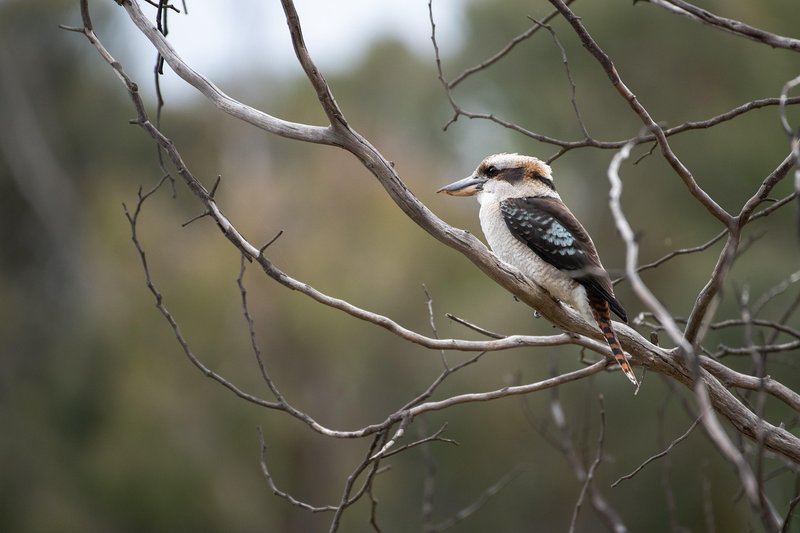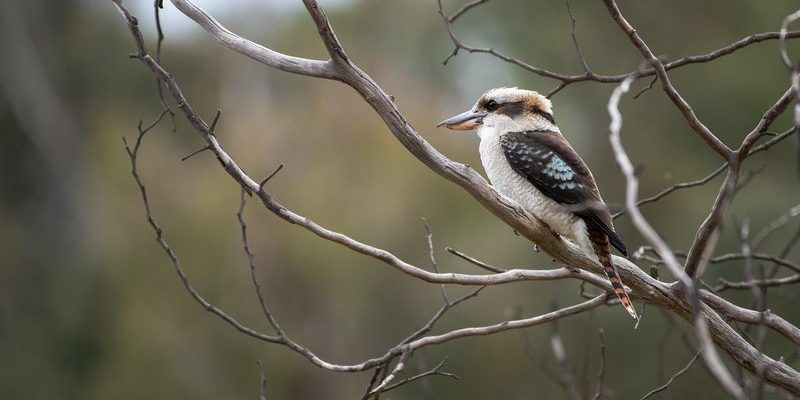
When you think of Australia, what comes to mind? Maybe it’s the stunning landscapes, unique wildlife, or the iconic Sydney Opera House. But one of the most delightful surprises in the Australian outback is the kookaburra. This bird, often dubbed the “laughing jackass,” is famous for its distinct, hearty laugh that fills the air with joy and whimsy. If you’ve ever heard its call, you’ll know it sounds like a series of hearty chuckles that echo through the trees, making one wonder if all the birds are having a good laugh at our expense!
The kookaburra is more than just a funny sound; it’s a symbol of the Australian bush. Known for its striking appearance and fascinating behavior, it’s a bird that captures the hearts of anyone lucky enough to spot one. In this article, we’ll explore everything you need to know about kookaburras—from their habitat and diet to their unique social behaviors and breeding habits. So, grab a cup of coffee, and let’s dive into the enchanting world of kookaburras!
What is a Kookaburra?
The kookaburra is a large kingfisher native to Australia and New Guinea. There are four species of kookaburra, but the most well-known is the laughing kookaburra. It’s easy to spot with its chunky body, large head, and distinctive blue wings. On average, kookaburras can grow up to 18 inches long, making them one of the largest kingfishers in the world.
These birds have a strong beak, which is adapted for catching prey. Kookaburras mainly eat small mammals, reptiles, and insects, but they are also known to feast on larger animals like snakes. With their keen eyesight, they can spot food from high up in their treetop perches. They are truly impressive hunters!
The kookaburra’s name comes from the Wiradjuri language of Australia, and it translates to “to laugh.” This name perfectly suits the bird’s famous call. When you hear it, you might find yourself laughing along, captivated by its joyful noise. It’s no wonder that kookaburras hold such a special place in the hearts of Australians.
Physical Characteristics
Kookaburras have striking physical features that make them stand out. Their feathers are predominantly brown and white, with bright blue markings on their wings and tails. This vibrant contrast not only makes them visually appealing but also provides some camouflage against the dappled light of their forest habitats.
Adult kookaburras typically have a stout body structure, with a large head that carries a powerful beak. Their eyes are sharp and alert, allowing them to spot potential prey from great distances. The size and shape of their beaks vary slightly between species, but they are all designed efficiently for hunting.
Juvenile kookaburras have a different look than adults; their plumage is less vibrant, often featuring lighter colors. This gradual change helps prepare them for their adult roles in the wild. As they mature, you’ll see those stunning blue feathers emerge, marking their growth into stunning, full-grown kookaburras.
Habitat and Range
Kookaburras are found throughout eastern and southern Australia, as well as in parts of New Guinea. These birds thrive in various environments, including woodlands, forests, and savannas. They prefer areas with plenty of trees, as they often nest in tree hollows or build their nests in branches.
One of the remarkable aspects of kookaburras is their adaptability. While they have a preference for open woodlands, they can also be spotted in urban areas, where parks and gardens provide suitable habitats. This versatility has allowed kookaburras to flourish even as urban development encroaches on their natural environments.
In their natural habitat, kookaburras often form small family groups. You’ll typically find them perched on branches, surveying the ground for food or engaging in playful antics with their fellow kookaburras. This camaraderie is one of the many aspects that make observing these birds such a delightful experience.
Social Behavior
Kookaburras are social and often live in family groups, which can include parents and their offspring. This strong family bond plays a vital role in their survival. Younger kookaburras often help their parents raise the next generation, assisting in feeding and protecting the young chicks. This behavior is fascinating and highlights the cooperative nature of these birds.
When kookaburras aren’t busy caring for their young, they’re often engaged in playful activities. You might see them wrestling or chasing each other around. Their playful demeanor adds a layer of charm to their already entertaining personalities. This social behavior is a reminder of the beauty of nature—it’s not just about survival, but also about connection and joy.
The kookaburra’s iconic call is not just for show; it plays a critical role in their social interactions. The distinct laughter helps communicate territory and can strengthen social bonds within their group. It’s a beautiful reminder of how communication can take many forms in the animal kingdom.
Diet and Hunting Techniques
Kookaburras are carnivorous birds that primarily feed on small mammals, reptiles, and insects. They are particularly fond of worms, beetles, and crickets, but they won’t shy away from a juicy snake if the opportunity arises! Their diet can vary depending on their location and the season, showcasing their adaptability in the wild.
When hunting, kookaburras employ a unique technique. They often perch high in the trees, scanning the ground below. Once they spot potential prey, they swoop down with impressive speed and accuracy. Their strong beaks enable them to catch and kill their prey quickly, ensuring they don’t lose their meal.
Kookaburras have also been known to employ a “waiting game.” They’ll sit patiently in one spot, waiting for an unsuspecting meal to come within reach before launching their attack. This patient, calculated approach highlights their intelligence and ability to strategize while hunting.
Breeding and Nesting Habits
Kookaburras typically breed during the warmer months, with courtship rituals that often involve elaborate displays and vocalizations. Mating pairs will build their nests in tree hollows or even in man-made structures, such as abandoned buildings. Once they find a suitable spot, they’ll lay between two to four eggs, which both parents take turns incubating for about 25 days.
After hatching, the chicks remain in the nest for several weeks before they venture out. During this period, the parents and older siblings work together to feed the chicks, allowing them to grow strong and ready for life outside the nest. This family-oriented approach ensures the young kookaburras have a better chance of survival in the wild.
As the fledglings grow, they may stay with their family to help raise new chicks. This cooperative behavior is key to their success and contributes to the tight-knit social structure seen in kookaburra groups. It’s heartwarming to witness how these birds work together, not just for survival, but also to foster connections within their family.
Conservation Status
Fortunately, kookaburras are not considered endangered. Their adaptability to different environments, including urban areas, has helped them maintain stable populations. However, habitat destruction and climate change pose potential threats. Ensuring that these birds have access to suitable habitats is vital for their continued survival.
In some regions, conservation efforts are underway to preserve natural habitats and promote biodiversity. By supporting these initiatives, we can help ensure that kookaburras and other native wildlife thrive for generations to come. It’s a team effort that requires everyone to play their part.
Moreover, raising awareness about kookaburras and their role in the ecosystem can contribute to their protection. Educating the public about their importance helps foster a deeper appreciation for these enchanting birds and the unique environments they inhabit.
Interesting Facts About Kookaburras
| Scientific Name: | Dacelo novaeguineae |
| Average Size: | 18 inches (45 cm) |
| Weight: | Up to 1.5 pounds (0.68 kg) |
| Diet: | Small mammals, insects, reptiles |
| Lifespan: | Up to 20 years in the wild |
FAQ
What does a kookaburra’s call sound like?
The kookaburra’s call is one of its most distinctive features. It sounds like a series of hearty, chuckling laughs. This unique sound echoes through the Australian bush and is often heard at dawn and dusk. Many people find it delightful and have even compared the laughter of kookaburras to human laughter, which adds to their charm.
Can kookaburras be kept as pets?
While kookaburras are fascinating birds, they are not suitable as pets. They are wild animals that thrive in their natural habitat. Keeping them in captivity is not only unethical but can also be illegal in many regions. It’s best to enjoy kookaburras in the wild or support conservation efforts that protect their natural habitats.
Are kookaburras social birds?
Yes, kookaburras are highly social and often live in family groups. They cooperate in caring for their young, which fosters strong family bonds. Their social interactions include playful activities, vocalizations, and group hunting, making them a joy to observe in the wild.
What do kookaburras eat?
Kookaburras are carnivorous birds that primarily eat small mammals, insects, and reptiles. Their diet can vary depending on the season and availability of food. They are skilled hunters that can catch prey from high perches in trees. They have been known to consume larger animals, such as snakes, if the opportunity arises.
Where can I find kookaburras?
Kookaburras can be found throughout eastern and southern Australia, as well as in parts of New Guinea. They thrive in various habitats, including woodlands, forests, and even urban parks. If you’re in these regions, keep an eye out for these distinctive birds perched on tree branches, ready to entertain you with their laughter!
How long do kookaburras live?
In the wild, kookaburras can live up to 20 years. Their lifespan can vary based on environmental factors, availability of food, and threats from predators. In captivity, with proper care, they may live even longer. Ensuring that kookaburras have access to good food and a safe environment contributes to their longevity.
Do kookaburras migrate?
Kookaburras are generally resident birds, meaning they do not migrate. They tend to stay within their territory year-round, as they have adapted well to their environments. While they may move locally in search of food, they typically maintain a stable home range throughout their lives.
Are kookaburras in danger of extinction?
No, kookaburras are not currently considered endangered. Their populations are stable, partly due to their adaptability to different habitats, including urban areas. However, conservation efforts are important to protect their natural environments from habitat destruction and climate change.
What role do kookaburras play in the ecosystem?
Kookaburras play a crucial role in their ecosystem as predators of small mammals and insects. By helping control these populations, they contribute to a balanced ecosystem. Their presence also indicates a healthy environment, as they thrive in well-maintained habitats with abundant food sources.

